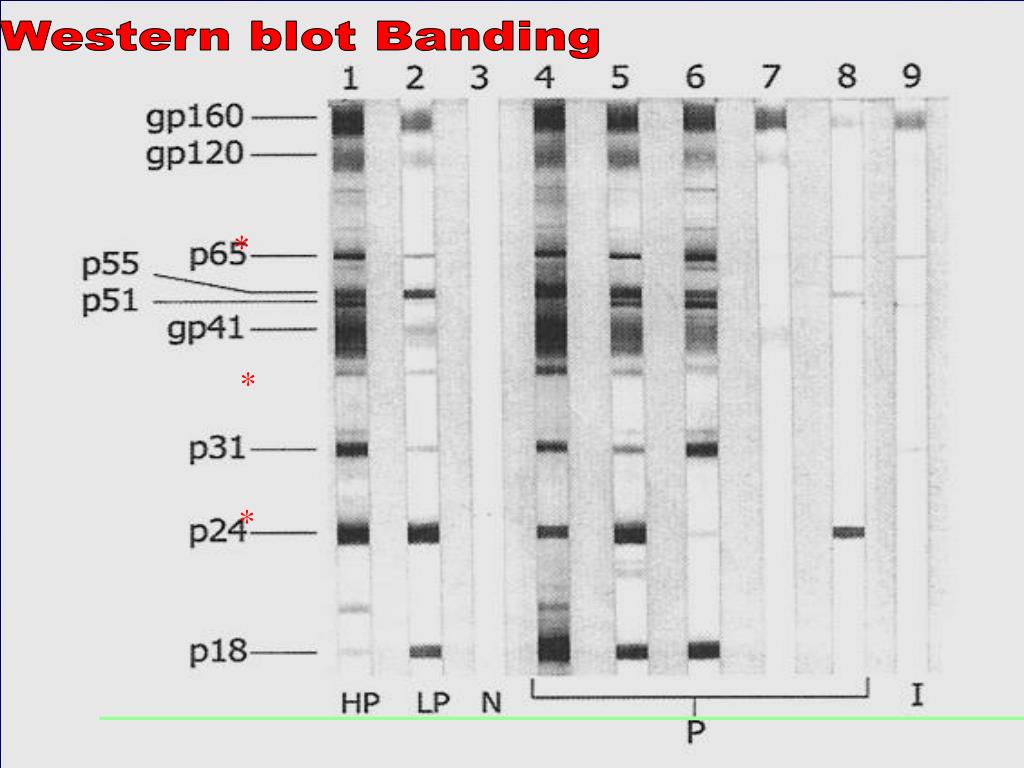

Envelope (gp120,gp160,gp41), GAG (p17,p24&p55) and POL(p51, p31 & p66).įor a sample to be HIV Positive, a Control band and at least 2 HIV envelope bands along with any 1 GAG or 1 POL band shall be present on the strip. The results are interpreted as Negative, Positive, or Indeterminate based on the presence of bands on the strip at the corresponding HIV Antigen. The test is run on strips blotted with HIV viral antigens, and the blue color bands appear on the strip after the test is completed due to the use of Alkaline phosphatase enzyme and BCIP –NBT substrate in the process. HIV Testing is performed using screening test Rapid /ELISA and samples found reactive in these tests are confirmed for their status by Western blot. The Western Blot test is the confirmatory test to detect antibodies to HIV (Human immunodeficiency virus), the causative agent of AIDS (Acquired Immunodeficiency Syndrome). Western blotting is used for the confirmatory medical diagnosis of various infectious diseases and, to name a few, HIV, bovine spongiform encephalopathy (BSE), hepatitis C (HCV), syphilis, and autoimmune disorders.Īs per WHO guidelines, this technique has been widely used as a more specific & supplemental assay on samples found initially reactive using ELISA and other screening tests for HIV.

Western blot is a technique used for protein detection from a mixture of proteins and has its application in immunology, molecular biology, biochemistry, and cell biology fields. Significance Of Malaria Antigens Over Antibodies.Sometimes an antibody test for Lyme disease finds antibodies to other bacteria. If Lyme disease bacteria DNA is found, you probably have an active Lyme disease infection.Once you have a Lyme disease infection, antibodies to the bacteria will usually stay in your body for the rest of your life. If antibodies are found, you may either have Lyme disease now or had the illness in the past.This is more likely with the antibody tests than with PCR.Īn abnormal, or positive, test for Lyme disease can mean one of the following: You have Lyme disease but it does not show up on the test ( false-negative).A negative PCR test usually means that you do not have a Lyme disease infection. A positive PCR test means the test detected Lyme disease bacteria DNA.Ī normal, or negative, test for Lyme disease can mean one of the following:.A negative PCR test means the test didn't detect Lyme disease bacteria DNA.The polymerase chain reaction (PCR) test may be done to confirm a Lyme infection if you have a positive antibody test result. An abnormal (positive) test means that Lyme disease antibodies are found.A normal (negative) test means that no Lyme disease antibodies are found.Test results are usually available in 1 to 2 weeks.Īn antibody test checks to see if you've had an infection from a bacteria that causes Lyme disease. The PCR test is a blood or urine test, but can also be done on fluid from the spine or from a joint. PCR testing may be used to identify a current (active) infection if you have symptoms of Lyme disease that have not gotten better with antibiotic treatment. Polymerase chain reaction (PCR) testing detects the genetic material ( DNA) of the Lyme disease bacteria. The Western blot test should be done for all people who've had a positive (or borderline positive) ELISA test. It is most often done to detect a chronic Lyme disease infection.Īntibody testing should be done in a two-step process, using the ELISA followed by the Western blot test. This test also identifies Lyme disease antibodies and can confirm the results of an ELISA test. This is a rapid test to identify Lyme disease antibodies. Enzyme-linked immunosorbent assay (ELISA).There are two types of antibody tests to detect Lyme disease. Finding antibodies to the Lyme disease bacteria does not tell whether you were infected recently or sometime in the past. Once formed, antibodies usually stay in your system for many years, even after successful treatment of the disease. It may take up to 2 months after becoming infected before antibodies can be detected in a blood test. Antibody testsĪntibody tests are the most commonly used tests to help identify Lyme disease. Other tests may be done in certain situations. Antibody tests can sometimes be used to help identify Lyme disease. If you and your doctor think you have Lyme disease, your doctor will do a careful medical history and physical exam. Lyme disease can be hard to diagnose because its symptoms are similar to those of many other illnesses. Lyme disease bacteria are spread by certain kinds of ticks. A Lyme disease test detects antibodies to the Lyme disease bacteria in the blood.


 0 kommentar(er)
0 kommentar(er)
